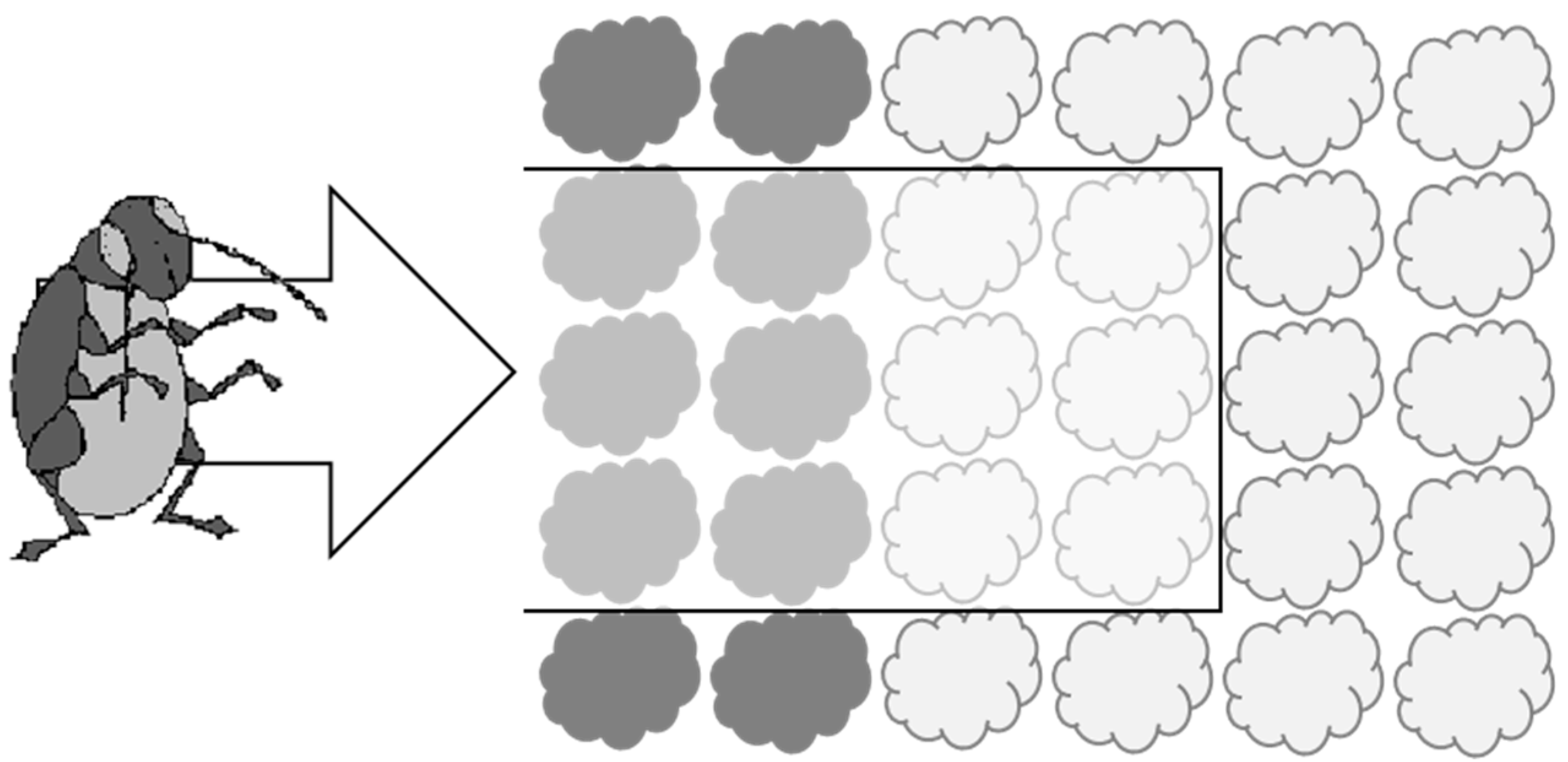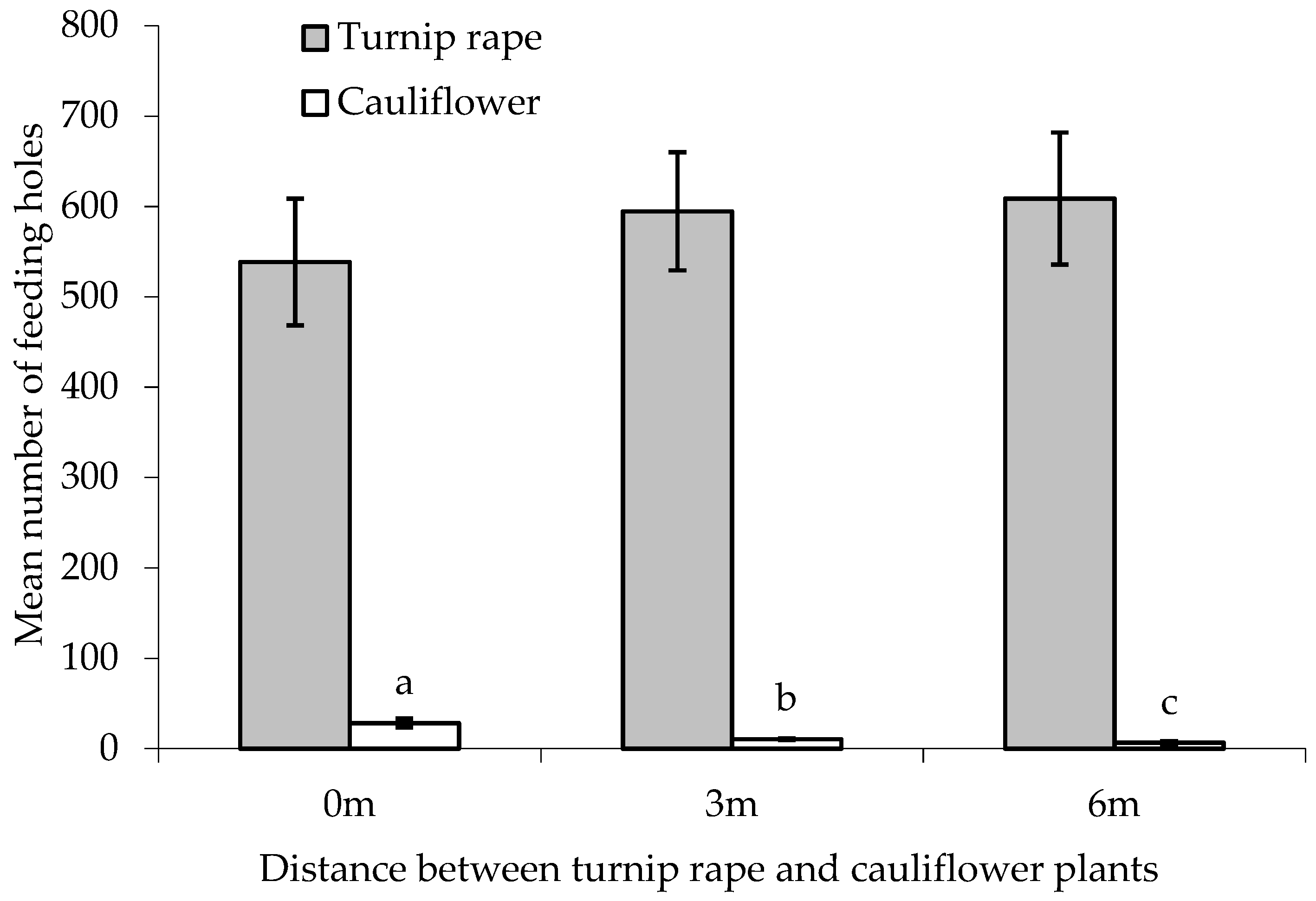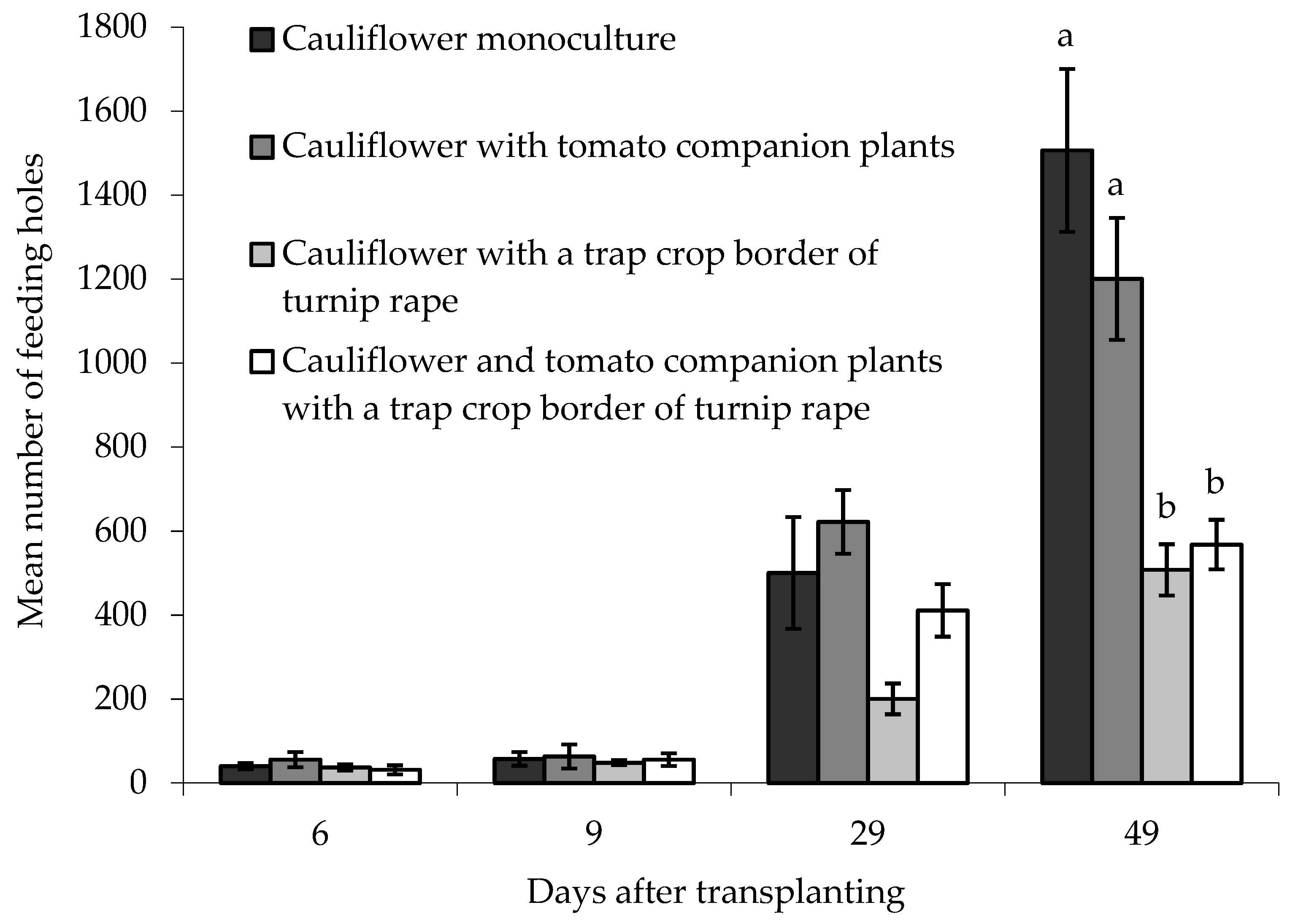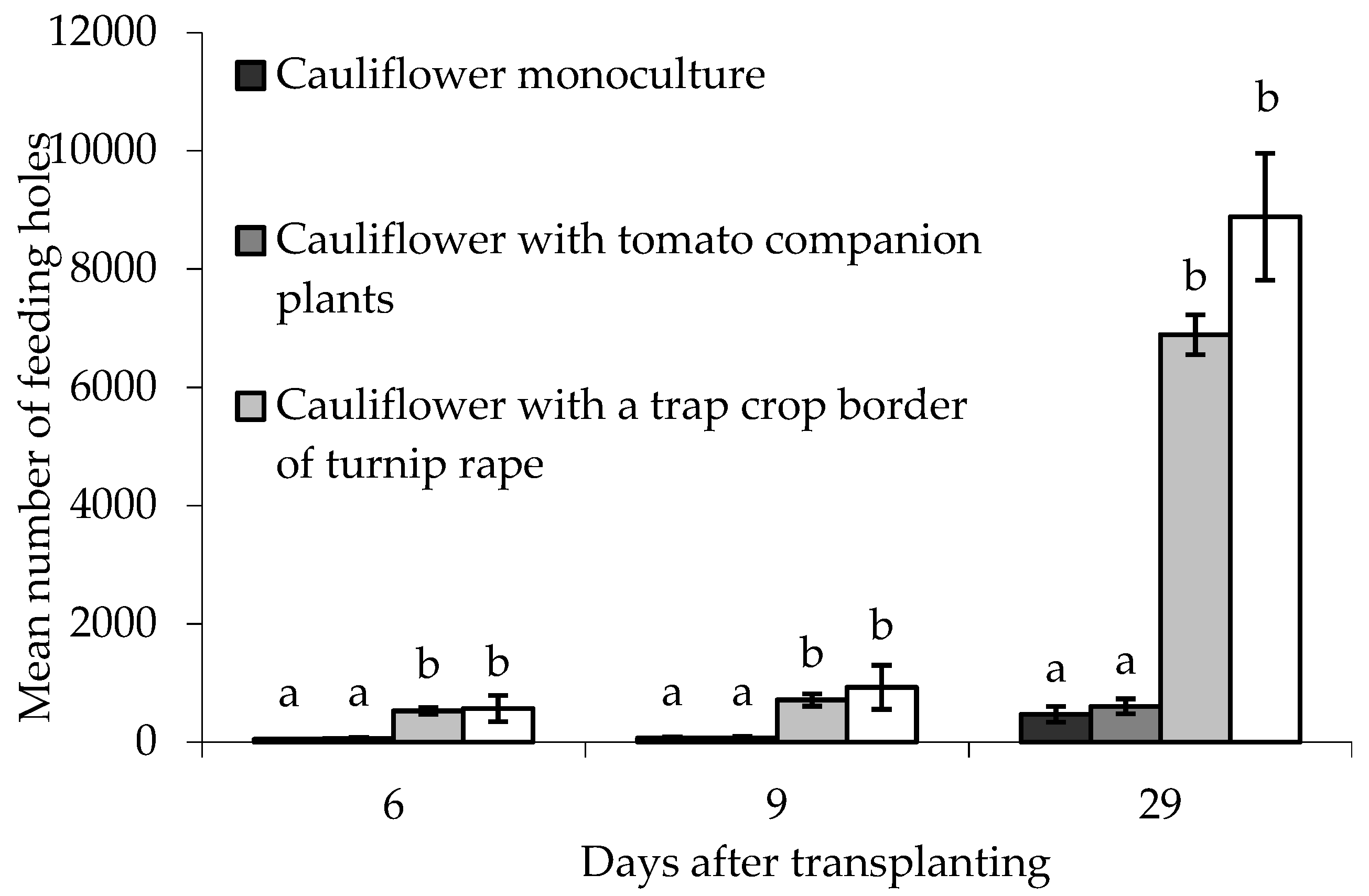Living on the Edge: Using and Improving Trap Crops for Flea Beetle Management in Small-Scale Cropping Systems
Abstract
1. Introduction
2. Materials and Methods
2.1. Study Site, Plants and Insects
2.2. Cage Study 1: Is Turnip Rape Effective as a Trap Crop for Flea Beetles?
2.3. Cage Study 2: Can the Effectiveness of Trap Crops Be Improved by Spatial Separation From Main Crops?
2.4. Field Study: Can the Effectiveness of Trap Crops be Improved Through Combination with Companion Plants?
2.5. Data Analysis
3. Results
3.1. Cage Study 1: Is Turnip Rape Effective as a Trap Crop for Flea Beetles?
3.2. Cage Study 2: Can the Effectiveness of Trap Crops Be Improved by Spatial Separation from Main Crops?
3.3. Field Study: Can the Effectiveness of Trap Crops Be Improved through Combination with Companion Plants?
4. Discussion
4.1. Cage Study 1: Is Turnip Rape Effective as a Trap Crop for Flea Beetles?
4.2. Cage Study 2: Can the Effectiveness of Trap Crops Be Improved by Spatial Separation from Main Crops?
4.3. Field Study: Can the Effectiveness of Trap Crops Be Improved through Combination with Companion Plants?
5. Conclusions
Author Contributions
Funding
Acknowledgments
Conflicts of Interest
References
- Lamichhane, J.R.; Dachbrodt-Saaydeh, S.; Kudsk, P.; Messéan, A. Toward a reduced reliance on conventional pesticides in European agriculture. Plant Dis. 2016, 100, 10–24. [Google Scholar] [CrossRef]
- George, D.R.; Banfield-Zanin, J.A.; Collier, R.; Cross, J.; Birch, A.N.E.; Gwynn, R.; O’Neill, T. Identification of novel pesticides for use against glasshouse invertebrate pests in UK tomatoes and peppers. Insects 2015, 6, 464–477. [Google Scholar] [CrossRef]
- Barbosa, P.; Hines, J.; Kaplan, I.; Martinson, H.; Szczepaniec, A.; Szendrei, Z. Associational resistance and associational susceptibility: Having right or wrong neighbors. Annu. Rev. Ecol. Evol. Syst. 2009, 40, 1–20. [Google Scholar] [CrossRef]
- Root, R.B. Organization of a plant-arthropod association in simple and diverse habitats: The fauna of collards (Brassica oleracea). Ecol. Monogr. 1973, 43, 95–124. [Google Scholar] [CrossRef]
- Andow, D.A. Vegetational diversity and arthropod population response. Annu. Rev. Entomol. 1991, 36, 561–586. [Google Scholar] [CrossRef]
- Mazzi, D.; Dorn, S. Movement of insect pests in agricultural landscapes. Ann. Appl. Biol. 2012, 160, 97–113. [Google Scholar] [CrossRef]
- Finch, S.; Collier, R.H. The influence of host and non-host companion plants on the behaviour of pest insects in field crops. Entomol. Exp. Appl. 2012, 142, 87–96. [Google Scholar] [CrossRef]
- Hokkanen, H.M.T. Trap cropping in pest management. Annu. Rev. Entomol. 1991, 36, 119–138. [Google Scholar] [CrossRef]
- Shelton, A.M.; Badenes-Perez, F.R. Concepts and applications of trap cropping in pest management. Annu. Rev. Entomol. 2006, 51, 285–308. [Google Scholar] [CrossRef]
- George, D.R.; Collier, R.; Port, G. Testing and improving the effectiveness of trap crops for management of the diamondback moth Plutella xylostella (L.): A laboratory-based study. Pest. Manag. Sci. 2009, 65, 1219–1227. [Google Scholar] [CrossRef]
- George, D.R.; Croft, P.; Northing, P.; Wäckers, F.L. Perennial field margins with combined agronomical and ecological benefits for vegetable rotation schemes. IOBC WPRS Bull. 2010, 56, 45–48. [Google Scholar]
- George, D.R.; Croft, P.; Wakefield, M.; Wäckers, F.L. Perennial field margins for functional biodiversity in UK vegetable rotation schemes: Establishment and resource provision. IOBC WPRS Bull 2012, 75, 77–81. [Google Scholar]
- Mitchell, E.R.; Hu, G.; Johanowicz, D. Management of diamondback moth (Lepidoptera: Plutellidae) in cabbage using collard as a trap crop. HortScience 2000, 35, 875–879. [Google Scholar] [CrossRef]
- Shelton, A.M.; Nault, B.A. Dead-end trap cropping to improve management of the diamondback moth, Plutella xylostella (Lepidoptera: Plutellidae). Crop Protect. 2004, 23, 497–503. [Google Scholar] [CrossRef]
- Dewar, A.M. The adverse impact of the neonicotinoid seed treatment ban on crop protection in oilseed rape in the United Kingdom. Pest. Manag. Sci. 2017, 73, 1305–1309. [Google Scholar] [CrossRef][Green Version]
- Vargas-Piqueras, P. Host Selection in Flea Beetles. Master’s Thesis, University of Newcastle upon Tyne, Newcastle upon Tyne, UK, 1974. [Google Scholar]
- Chittenden, F.H.; Marsh, H.O. The Western Cabbage Flea Beetle; USDA Bulletin: Washington, DC, USA, 1920.
- Altieri, M.A.; Schmidt, L.L. Population trends and feeding preferences of flea beetles (Phyllotreta cruciferae Goeze) in collard-wild mustard mixtures. Crop Protect. 1986, 5, 170–175. [Google Scholar] [CrossRef]
- Al-Doghairi, M.A. Pest Management Tactics for the Western Cabbage Flea Beetle. Ph.D. Thesis, Colorado State University, Fort Collins, CO, USA, 1999. [Google Scholar]
- Parker, B.; Howard, J.; Binks, R.; Finch, S.; Jukes, A. Brassicas: Biology and control of brassica flea beetles by integrating trap crops with insecticide use. HDC Final Rep. Project FV 2002, 222, 1–23. [Google Scholar]
- Barari, H.; Cook, S.; Clark, S.; Williams, I. Effect of a turnip rape (Brassica rapa) trap crop on stem-mining pests and their parasitoids in winter oilseed rape (Brassica napus). BioControl 2005, 50, 69–86. [Google Scholar] [CrossRef]
- Trdan, S.; Valic, N.; Znidarcic, D.; Vidrih, M.; Bergant, K.; Zlatic, E.; Milevoj, L. The role of Chinese cabbage as a trap crop for flea beetles (Coleoptera: Chrysomelidae) in production of white cabbage. Sci. Hortic. 2005, 106, 12–24. [Google Scholar] [CrossRef]
- Conboy, N.; McDaniel, T.; Ormerod, A.; George, D.; Gatehouse, A.; Wharton, E.; Donohoe, P.; Curtis, R.; Tosh, C. Companion planting with French marigolds protects tomato plants from glasshouse whiteflies through the emission of airborne limonene. PLoS ONE 2009, 14, e0213071. [Google Scholar] [CrossRef]
- Khan, Z.R.; Pickett, J.A.; van den Berg, J.; Wadhams, L.J.; Woodcock, C.M. Exploiting chemical ecology and species diversity: Stem borer and striga control for maize and sorghum in Africa. Pest. Manag. Sci. 2000, 56, 957–962. [Google Scholar] [CrossRef]
- Cook, S.M.; Khan, Z.R.; Pickett, J.A. The use of ‘push-pull’ strategies in integrated pest management. Annu. Rev. Entomol. 2007, 52, 375–400. [Google Scholar] [CrossRef]
- Midega, C.A.O.; Khan, Z.R.; Van Den Berg, J.; Ogol, C.K.P.O.; Dippenaar-Schoeman, A.S.; Pickett, J.A.; Wadhams, L.J. Response of ground-dwelling arthropods to a ‘push–pull’ habitat management system: Spiders as an indicator group. J. Appl. Entomol. 2008, 132, 248–254. [Google Scholar] [CrossRef]
- George, D.R.; Port, G.; Collier, R.H. Selection of trap crop and companion plants for the management of pest insects in field vegetables. IOBC WPRS Bull. 2007, 30, 113–121. [Google Scholar]
- Metspalu, L.; Kruus, E.; Ploomi, A.; Williams, I.H.; Hiiesaar, K.; Jõgar, K.; Veromann, E.; Mänd, M. Flea beetle (Chrysomelidae: Alticinae) species composition and abundance in different cruciferous oilseed crops and the potential for a trap crop system. Acta Agric. Scand. Sect. B Soil Plant Sci. 2014, 64, 572–582. [Google Scholar] [CrossRef]
- Parker, J.E.; Crowder, D.W.; Eigenbrode, S.D.; Snyder, W.E. Trap crop diversity enhances crop yield. Agric. Ecosyst. Environ. 2016, 232, 254–262. [Google Scholar] [CrossRef]
- Potting, R.P.J.; Perry, J.N.; Powell, W. Insect behavioural ecology and other factors affecting the control efficacy of agro-ecosystem diversification strategies. Ecol. Model. 2005, 182, 199–216. [Google Scholar] [CrossRef]
- Gonzalez, A.; Eastman, C. Influence of Intercropping and Trap Cropping on Diamondback Moth and its Natural Enemies; INHS Report: Spokane, WA, USA, 2000. [Google Scholar]
- Finch, S.; Collier, R.H. Host-plant selection by insects—A theory based on ‘appropriate/inappropriate landings’ by pest insects of cruciferous plants. Entomol. Exp. Appl. 2000, 96, 91–102. [Google Scholar] [CrossRef]
- Henderson, A.E.; Hallett, R.H.; Soroka, J.J. Prefeeding behaviour of the crucifer flea beetle, Phyllotreta cruciferae, on host and non host crucifers. J. Insect Behav. 2004, 17, 17–39. [Google Scholar] [CrossRef]
- Holden, M.H.; Ellner, S.P.; Lee, D.-H.; Nyrop, J.P.; Sanderson, J.P. Designing an effective trap cropping strategy: The effects of attraction, retention and plant spatial distribution. J. Appl. Ecol. 2012, 49, 715–722. [Google Scholar] [CrossRef]
- Siekmann, G.; Hommes, M. Exclusion fences against cabbage root fly and carrot fly. IOBC WPRS Bull. 2007, 30, 107–112. [Google Scholar]
- Tillman, P.G. Physical barriers for suppression of movement of adult stink bugs into cotton. J. Pest. Sci. 2014, 87, 419–427. [Google Scholar] [CrossRef]
- Accinelli, G.; Lanzoni, A.; Ramilli, F.; Dradi, D.; Burgio, G. Trap crop: An agroecological approach to the management of Lygus rugulipennis on lettuce. Bull. Insectol. 2005, 58, 9–14. [Google Scholar]
- Tillman, P.G.; Mullinix, B.G., Jr. Grain sorghum as a trap crop for corn earworm (Lepidoptera: Noctuidae) in cotton. Environ. Entomol. 2004, 33, 1371–1380. [Google Scholar] [CrossRef]
- Sarkar, S.C.; Wang, E.; Wu, S.; Lei, Z. Application of trap cropping as companion plants for the management of agricultural pests: A review. Insects 2018, 9, 128. [Google Scholar] [CrossRef]
- Adler, L.S.; Hazzard, R.V. Comparison of perimeter trap crop varieties: Effects on herbivory, pollination, and yield in butternut squash. Environ. Entomol. 2009, 38, 207–215. [Google Scholar] [CrossRef]
- AMPAC. Tech Sheet: Pasja—Hybrid Forage Brassica. Available online: http://www.ampacseed.com/pasja.htm. (accessed on 26 June 2019).
- Banks, J.E.; Ekbom, B. Modelling herbivore movement and colonization: Pest management potential of intercropping and trap cropping. Agric. Forest Entomol. 1999, 1, 165–170. [Google Scholar] [CrossRef]
- Andow, D.A.; Nicholson, A.G.; Wien, H.C.; Wilson, H.R. Insect populations on cabbage grown with living mulches. Environ. Entomol. 1986, 15, 293–299. [Google Scholar] [CrossRef]
- Wiech, K. Intercropping as a possible method of cabbage pest control in Poland. In Proceedings of the Brighton Crop Protection Conference: Pests & Diseases, Brighton, UK, 18–21 November 1996; pp. 675–678. [Google Scholar]
- Garcia, M.A.; Altieri, M.A. Explaining differences in flea beetle Phyllotreta cruciferae Goeze densities in simple and mixed broccoli cropping systems as a function of individual behaviour. Entomol. Exp. Appl. 1992, 62, 201–209. [Google Scholar] [CrossRef]
- Gao, Z.Z.; Wu, W.J.; Cui, Z.X. The effect of intercrop on the densities of Phyllotreta striolata (F.). Chin. Agric. Sci. Bull. 2004, 20, 214–216. [Google Scholar]
- Kianmatee, S.; Ranamukhaarachchi, S.L. Pest repellent plants for management of insect pests of Chinese kale, Brassica oleracea L. Int. J. Agric. Biol. 2007, 9, 64–67. [Google Scholar]
- Jankowska, B.; Poniedziałek, M.; Jędrszczyk, E. Effect of intercropping white cabbage with French marigold (Tagetes patula nana L.) and pot marigold (Calendula officinalis L.) on the colonization of plants by pest insects. Folia Hortic. 2009, 21, 95–103. [Google Scholar] [CrossRef]
- Billiald, H. The Effect of Diverse Backgrounds on Host Plant Selection by Two Fly Pests of Field Vegetable Crops. Master’s Thesis, Imperial College of Science, Technology and Medicine, London, UK, 2001. [Google Scholar]
- Morley, K.; Finch, S.; Collier, R. Companion planting—Behaviour of the cabbage root fly on host plants and non-host plants. Entomol. Exp. Appl. 2005, 117, 15–25. [Google Scholar] [CrossRef]
- George, D.R.; Collier, R.H.; Whitehouse, D.M. Can imitation companion planting interfere with host selection by Brassica pest insects? Agric. Forest Entomol. 2013, 15, 106–109. [Google Scholar] [CrossRef]







| Plant Growth Characteristics | Environmental Conditions | ||||||||
|---|---|---|---|---|---|---|---|---|---|
| Experiment | Plant Species | Mean ht (cm) | Mean Leaf no. | Mean Leaf Area (cm2 × 0.01) | n | Mean Min Temp (°C) | Mean Max Temp (°C) | Mean Daily Rainfall (mm) | % Days Rain Free |
| Cage study 1 | Cauliflower | 24.4 ± 0.4 | 7.7 ± 0.2 | 29.6 ± 0.8 | 10 | 9.6 ± 0.8 | 17.1 ± 1.4 | 1.4 ± 0.6 | 50 |
| Turnip rape | 36.9 ± 1.4 | 9.8 ± 0.4 | 91.3 ± 9.0 | 10 | |||||
| Cage study 2 | Cauliflower | 26.5 ± 0.3 | 8.9 ± 0.1 | 48.3 ± 1.4 | 30 | 8.7 ± 0.7 | 15.1 ± 0.8 | 1.4 ± 0.5 | 50 |
| Turnip rape | 23.6 ± 0.5 | 10.3 ± 0.3 | 62.8 ± 2.9 | 30 | |||||
| Field study | Cauliflower | 30.0 ± 0.8 | 11.0 ± 0.3 | 96 | 11.5 ± 0.3 | 18.5 ± 0.5 | 2.8 ± 0.7 | 54 | |
| Turnip rape | 65.9 ± 1.9 | 39.3 ± 2.0 | 24 | ||||||
| Tomato | 60.0 ± 1.9 | 72.2 ± 3.4 | 24 | ||||||
| Border Plant Treatment | % Preference for Border Plants | Total Number of Feeding Holes |
|---|---|---|
| Turnip rape | 96.41 ± 5.22a | 1557.50 ± 133.58a |
| Cauliflower | 60.39 ± 3.66b | 218.80 ± 26.50b |
| Bare soil | NA | 102.70 ± 16.81c |
| Z/F(2,24) | −3.78 | 108.59 |
| p | <0.001 | <0.001 |
| Treatment | % Preference for Border Plants | Total Number of Feeding Holes |
|---|---|---|
| 0 m | 94.30 ± 0.96a | 538.60 ± 70.17 |
| 3 m | 98.11 ± 0.22b | 594.60 ± 65.45 |
| 6 m | 98.75 ± 0.37b | 608.80 ± 73.10 |
| F(2,24) | 18.82 | 0.26 |
| p | <0.001 | 0.77 |
| % Preference for Border Plants | Total Number of Feeding Holes | |||||
|---|---|---|---|---|---|---|
| Treatment | 6 DAT | 9 DAT | 29 DAT | 6 DAT | 9 DAT | 29 DAT |
| Cauliflower monoculture | 55.20 ± 4.37a | 55.03 ± 11.29 | 47.99 ± 0.67a | 88.67 ± 9.06a | 125.00 ± 16.80a | 967.67 ± 265.06a |
| Cauliflower with tomato companion plants | 52.62 ± 13.70a | 53.18 ± 13.89 | 48.33 ± 3.20a | 116.00 ± 11.37a | 132.00 ± 33.62a | 1224.33 ± 196.46a |
| Cauliflower with a trap crop border of turnip rape | 93.51 ± 0.72b | 93.27 ± 1.45 | 97.19 ± 0.43b | 561.33 ± 64.28b | 759.67 ± 99.35b | 7091.33 ± 359.34b |
| Cauliflower and tomato companion plants with a trap crop border of turnip rape | 94.54 ± 0.70b | 92.84 ± 2.97 | 95.57 ± 0.36b | 598.33 ± 232.98b | 981.00 ± 370.95b | 9294.67 ± 1123.06b |
| F(3,6) | 14.17 | 6.15 | 302.38 | 20.48 | 16.41 | 33.57 |
| p | 0.004 | 0.29 | <0.001 | 0.001 | 0.003 | <0.001 |
© 2019 by the authors. Licensee MDPI, Basel, Switzerland. This article is an open access article distributed under the terms and conditions of the Creative Commons Attribution (CC BY) license (http://creativecommons.org/licenses/by/4.0/).
Share and Cite
George, D.; Port, G.; Collier, R. Living on the Edge: Using and Improving Trap Crops for Flea Beetle Management in Small-Scale Cropping Systems. Insects 2019, 10, 286. https://doi.org/10.3390/insects10090286
George D, Port G, Collier R. Living on the Edge: Using and Improving Trap Crops for Flea Beetle Management in Small-Scale Cropping Systems. Insects. 2019; 10(9):286. https://doi.org/10.3390/insects10090286
Chicago/Turabian StyleGeorge, David, Gordon Port, and Rosemary Collier. 2019. "Living on the Edge: Using and Improving Trap Crops for Flea Beetle Management in Small-Scale Cropping Systems" Insects 10, no. 9: 286. https://doi.org/10.3390/insects10090286
APA StyleGeorge, D., Port, G., & Collier, R. (2019). Living on the Edge: Using and Improving Trap Crops for Flea Beetle Management in Small-Scale Cropping Systems. Insects, 10(9), 286. https://doi.org/10.3390/insects10090286






